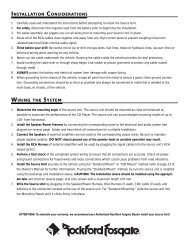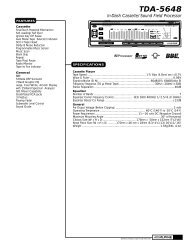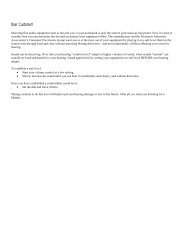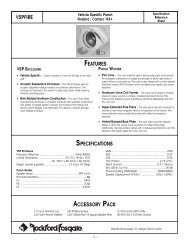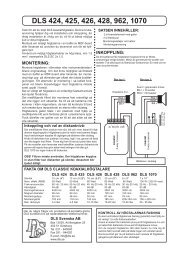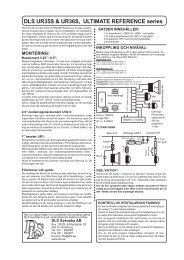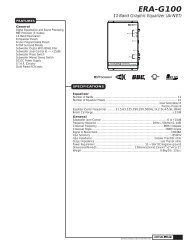Small Room Acoustics De-Mythologized - Eporia
Small Room Acoustics De-Mythologized - Eporia
Small Room Acoustics De-Mythologized - Eporia
Create successful ePaper yourself
Turn your PDF publications into a flip-book with our unique Google optimized e-Paper software.
®Equalization for ImprovementProbably the best thing to do first to optimize the listening conditions of a sound system isto reduce standing waves and resonances as much as possible. Standing waves in a roomwill distort the natural shape of the reverberation curve, as in figure 6. Try to eliminatelarge parallel surfaces. Large pieces of furniture with irregular surfaces such as bookcasescan reduce standing waves by adding diffusion to the reflected sounds. Sound absorbingmaterials or structures can be applied in some cases, although low-frequency absorbers arenecessarily large. Flexible walls, such as sheetrock on steel studs are quite good at absorbinglow frequencies, especially if backed by damping material such as rock wool insulation.Draperies, if made of dense material, are effective at mid and high frequencies, butare not very good absorbers of very low frequencies. Carpets and overstuffed furniturehelp prevent the floor and ceiling from resonating. Of course a cathedral or sloping ceilingis much preferred, but not always practical. Avoid placing the listening position near hardreflecting surfaces. Then, experiment with speaker placement while listening at manylocations in the room, and try to establish the placement which provides the most uniformlow-frequency response, consistent with domestic harmony. The listening position canseldom be one precise location. Try to find a combination of speaker and listener positionsthat result in the least change in the sound.After these steps are taken, electrical equalization can be very beneficial. A suitablegraphic equalizer will be found to work well. In most rooms with standing wave problems,it will be found that the low frequencies will be the most troublesome, and that severalmaxima will be quite close together in frequency. At higher frequencies, it will be foundthat the resonances are blending together into a smoother overall response. For thisreason, the equalizer used should have narrower bands (i.e. one-third or one-half octave)at the lowest frequencies and need not be so narrow at mid and high frequencies. Thebroader the bands, or the more gentle the adjustments that can be used at mid and highfrequencies, the better the result the equalization will produce. The response will bemore uniform.12





